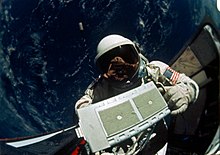Gemini 12
| COSPAR ID | 1966-104A |
|---|---|
| SATCAT no. | 02566 |

 | |
Gemini 12 (officially Gemini XII) was a 1966 manned spaceflight in NASA's Project Gemini. It was the 10th and final manned Gemini flight, the 18th manned American flight and, including X-15 flights over 100 kilometres (62 mi), the 26th spaceflight of all time.
Crew
| Position | Astronaut | |
|---|---|---|
| Command Pilot | James A. Lovell, Jr Second spaceflight | |
| Pilot | Edwin E. Aldrin, Jr First spaceflight | |
Backup crew
| Position | Astronaut | |
|---|---|---|
| Command Pilot | L. Gordon Cooper, Jr. | |
| Pilot | Eugene A. Cernan | |
Support crew
- Stuart A. Roosa (Cape CAPCOM)
- Charles Conrad Jr. (Houston CAPCOM)
- William A. Anders (Houston CAPCOM)
Mission parameters

- Mass: 3,762.1 kilograms (8,294 lb)
- Perigee: 160.8 kilometres (99.9 mi)
- Apogee: 270.6 kilometres (168.1 mi)
- Inclination: 28.87°
- Period: 88.87 min
Docking
- Docked: November 12, 1966 - 01:06:00 UTC
- Undocked: November 13, 1966 - 20:18:00 UTC
Space walk
- Aldrin - EVA 1 - (stand up)
- Start: November 12, 1966, 16:15:00 UTC
- End: November 12, 1966, 18:44:00 UTC
- Duration: 2 hours, 29 minutes
- Aldrin - EVA 2
- Start: November 13, 1966, 15:34:00 UTC
- End: November 13, 1966, 17:40:00 UTC
- Duration: 2 hours, 06 minutes
- Aldrin - EVA 3 (stand up)
- Start: November 14, 1966, 14:52:00 UTC
- End: November 14, 1966, 15:47:00 UTC
- Duration: 0 hours, 55 minutes
Objectives


At the completion of the previous Gemini flight, the program still had not demonstrated that an astronaut could work easily and efficiently outside the spacecraft. In preparation for Gemini XII new, improved restraints were added to the outside of the capsule, and a new technique—underwater training—was introduced, which would become a staple of future space-walk simulation. Aldrin's two-hour, 20-minute tethered space-walk, during which he photographed star fields, retrieved a micrometeorite collector and did other chores, at last demonstrated the feasibility of extravehicular activity. Two more stand-up EVAs also went smoothly, as did the by-now routine rendezvous and docking with an Agena which was done "manually" using the onboard computer and charts when a rendezvous radar failed. The climb to a higher orbit, however, was canceled because of a problem with the Agena booster.
Many documentaries[example needed] afterward largely credit the spacewalk innovations, including the underwater training, to Aldrin himself.
Gemini 12 was designed to perform rendezvous and docking with the Agena target vehicle, to conduct three extra-vehicular activity (EVA) operations, to conduct a tethered stationkeeping exercise, to perform docked maneuvers using the Agena propulsion system to change orbit, and demonstrate an automatic reentry.
| Gemini 12 | Agena info |
|---|---|
| Agena | GATV-5001A |
| NSSDC ID: | 1966-103A |
| Mass | 3,175 kilograms (7,000 lb) |
| Launch site | LC-14 |
| Launch date | November 11, 1966 |
| Launch time | 19:07:58 UTC |
| 1st perigee | 294.7 kilometres (183.1 mi) |
| 1st apogee | 303.2 kilometres (188.4 mi) |
| Period | 90.56 m |
| Inclination | 28.86 |
| Reentered | November 15, 1966 |
Experiments
The 14 scientific experiments were (1) frog egg growth under zero-g, (2) synoptic terrain photography, (3) synoptic weather photography, (4) nuclear emulsions, (5) airglow horizon photography, (6) UV astronomical photography, and (7) dim sky photography. Two micrometeorite collection experiments, as well as three space phenomena photography experiments, were not fully completed.
Reentry

The capsule was controlled on reentry by computer and splashed down 4.8 kilometers from its target.
The Gemini 12 mission was supported by the following U.S. Department of Defense resources; 9,775 personnel, 65 aircraft and 12 ships.
Insignia
The patch's unique orange and black colors are a link to the flight's original scheduled date close to Halloween. The Roman numeral XII is located at the 12 o'clock position on the face of a clock, with the Gemini spacecraft pointing to it like the hour hand of a clock. This represents the position of Gemini 12 as the last flight of the Gemini program. With the Apollo project following this last flight of the Gemini program, the ultimate objective—the moon—is symbolized by the crescent on the left.
Spacecraft location
After several years at the Museum of Transport and Technology, in Auckland, New Zealand, the spacecraft was returned to the United States. It is now on display at the Adler Planetarium, Chicago, Illinois. Lovell and Aldrin were reunited with the spacecraft November 9, 2006 during the opening for Adler's "Shoot for the Moon" exhibit, almost 40 years after the mission launched. Lovell and Aldrin's voices are used for the exhibit's recorded narration.
See also

- Agena Target Vehicle
- Extra-vehicular activity
- List of spacewalks
- Splashdown
- Solar eclipse of November 12, 1966
- Space suit
References
![]() This article incorporates public domain material from websites or documents of the National Aeronautics and Space Administration.
This article incorporates public domain material from websites or documents of the National Aeronautics and Space Administration.
External links
- NASA Gemini 12 press kit - Nov 3, 1966
- Gemini 12 Mission Report (PDF) January 1967
- On The Shoulders of Titans: A History of Project Gemini: http://www.hq.nasa.gov/office/pao/History/SP-4203/cover.htm
- Spaceflight Mission Patches: http://www.genedorr.com/patches/Intro.html
- http://nssdc.gsfc.nasa.gov/database/MasterCatalog?sc=1966-104A
- U.S. Space Objects Registry http://usspaceobjectsregistry.state.gov/search/index.cfm
- "Gemini 12 photographs". University of Missouri–St. Louis.
- Gemini XII Cockpit in crosseyed-3D stereoview format

